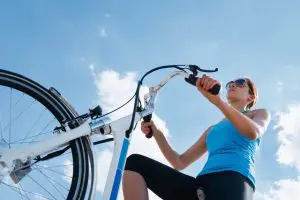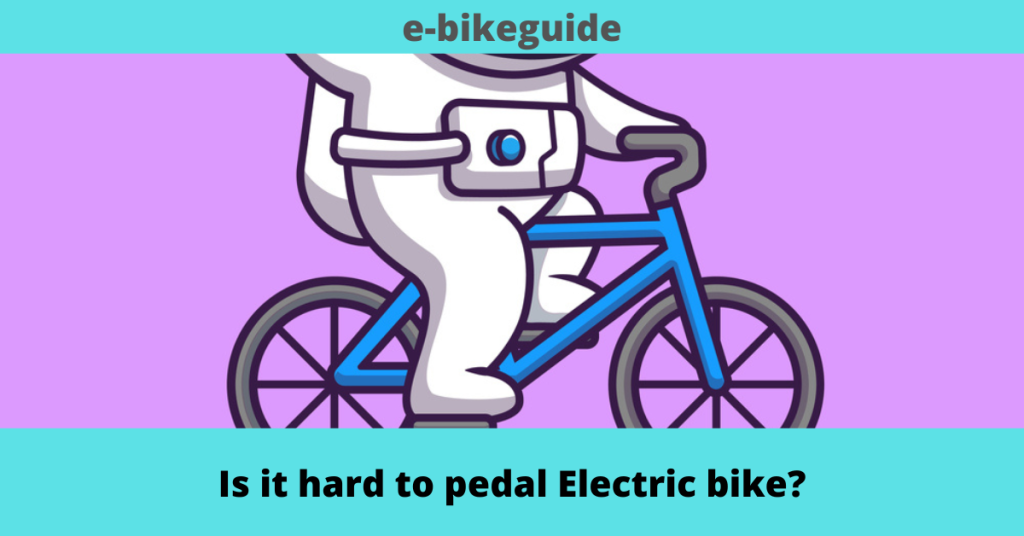Do I have a hard time pedaling an E-bike?

Demand for electric bikes is going up very vigorously. It is not merely because of being an eco-friendly vehicle but also user-friendliness. Riding an E-bike is almost similar to riding a traditional bike. Gear charging, steering, braking, and all other fundamentals are almost similar. The only difference is the power supply. An e-bike needs more energy to go a mile than a bike with no motor. Then the weight of the e-bike will be more.
In some instances, it is not necessary to paddle the E-bike. If you are not convenient to pedal, then look for a bike with a throttle. The e-bike with only a throttle is similar to a motorcycle.
The gear, tire pressure, rider weight, cycle speed, terrain, headwind, battery age, and assistance setting will all have an impact on the range. Depending on usage, age, and maintenance, the charging capacity will be declined over time.
Even when the electricity is turned off and the battery is still inside the bike, an e-bike will still handle like a conventional bike at speeds lower than 10 mph. Even when the electricity is turned off and the battery is still inside the bike, an e-bike will still handle like a conventional bike at speeds lower than 10 mph. Due to the weight of the entire bike, it is quite difficult to maintain 15 to 20 mph speed on an e-bike while the power is off.
Weight of the E-bike

E-bike is relatively heavier than a traditional bike. The minimum weight of the available bikes in the market is 50 pounds/23 Kg or more. Because of this heaviness, it requires more effort in paddling. Therefore, the riders who have already experienced paddling a typical bike, do not wish to ride with an E-bike.
Even though, E-bike is relatively heavy you will be familiar with the bike over time. However, there are more models which encourage the rider to enjoy paddling.
The additional air resistance is more of a concern than the added weight. An effective freewheel mechanism is rare in e-bikes. Additionally, pedal gearboxes sometimes only have one or three speeds. Since the bike is not designed primarily for pedal-only usage, the tires have a higher section and lower pressure, favoring comfort above performance.
Will the easiness of the pedaling depend on the type of the E-bike?

The pedal mechanism is one of the most enigmatic features of many high-end electric bikes. You might be curious about how an eBike operates and how much effort it requires to use before you ever get on it. If you’re interested, you may read about the lifespan of electric bikes to see how far your money will go. To extend the lifespan of your bike, you should also learn how to test the electric bike motor and identify any potential issues. The pedal mechanism is one of the most enigmatic features of many high-end electric bikes.
The type of the E-bike and the purpose of use are two factors that are directly influenced by the paddling requirement of the bike. Paddling on a flat surface is much easier than on hills. If your purpose is to ride on your commute, then the properties to be considered are different rather than hills. Therefore, the requirement for energy is less in commuting e-bikes.
Similarly, if you buy an E-bike for an adventurous bike, it will not more suitable for daily commute travel. Because the paddling system has developed into steep paths.
There are different types of E-bikes. You can decide what to purchase based on your preference.
The bikes in Class 1 and 3 grades have assisted with the pedal. Therefore, a motor is available with those bikes. When you are pedaling the motor will be powered up. Therefore, the rider has to provide a little effort to keep maintain the power. These e-bikes are known as “Pedelecs” which refers to pedal-assisted E-bikes.
Class 2 types of E-bikes are available with a throttle. The operation of this bike is similar to a Motorcycle. This bike is commonly known as a “Twist and go” type bike.
There is no exact answer to the question of whether the E-bike is difficult to pedal or not. Several factors affect the answer to this question. I have listed those factors below for you to determine your answer.
Is paddling comfortably with heavy bikes?

Paddling a heavy bike is difficult. However, you have to make sure that you are physically and mentally fit to do it. I suggest you wear waterproofing clothes for riding. Do you wish to practice with an E-bike?
You can practice the E-bike before riding its daily use. We suggest you practice with and without the battery. You also have to make sure that the battery is fully charged. Then, you do not want to worry about low-power batteries while riding.
Class 01 and 03 bikes are bikes with pedal assistance. Paddling will assist to recharge the battery. The Pedelec bike provides power to the battery soon after you start riding.
When you ride a Class 2 bike, make sure that you turn the throttle. This type of bike will ensure easy twisting or pushing the throttle with less or no effort.
It does make the bike quite heavy, giving the impression that you are riding through desert sand. Even if the motorcycles have become lighter, they still weigh a substantial 22 to 23 kilos, which is quite a bit even without the motor. The weight will make climbing more difficult as well.
You may still enjoy the freedom of riding an e-bike if you have a heart condition, aching knees, or any other condition. Some people in good health will also like the freedom of an e-bike ride. It does make the bike quite heavy, giving the impression that you are riding through desert sand. Even if the motorcycles have become lighter, they still weigh a substantial 22 to 23 kilos, which is quite a bit even without the motor. The weight will make climbing more difficult as well.
The power of the e-bike or recharging of the engine is transferred exclusively at the pedals to the drivetrain.
The efficiency of power transmission increases with the stiffness of the pedals, cranks, bottom brackets, and frame.
If your pedals were made of rubber or some gentler material, each time you pushed the pedal, energy would be lost crushing the rubber.
Better power transmission is achieved by using a good race pedal in conjunction with rigid-soled cycling shoes. The rider’s power (the engine) is transferred exclusively at the pedals to the drivetrain.
The efficiency of power transmission increases with the stiffness of the pedals, cranks, bottom brackets, and frame.
If your pedals were made of rubber or some gentler material, each time you pushed the pedal, energy would be lost crushing the rubber.
Better power transmission is achieved by using a good race pedal in conjunction with rigid-soled cycling shoes.
Is there any difference between pedal-assisted E-bikes and Throttle?

An electric bike comes with pedals that may be operated manually and get the push from the engine. The key component of this functionality is Pedelec or EPAC (Electronically Power Assisted Cycles).
On the other hand, it is important to note the legal requirement. Because some countries issue licenses for E-bike riding. Despite your preference check with the legal system as well.
Throttle e-bikes, also known as twist and go e-bikes, are a type of electric bike that resembles electric mopeds more than a typical bicycle. The argument that they are difficult to pedal is irrelevant because you do not have to pedal. Of course, getting to your destination would be difficult if the battery is dead.
Here are some advantages of an e-Bike system with Pedelec support. buying an E-bike, you may think of what E-bike will serve your requirement. Whether pedaling E-bike or bike with a throttle will make it easy. I have listed a few advantages of the Pedelec E-bike below.
-
Different Power Modes
The diversity of options available in how different eBikes operate is one of the most distinctive features of an electric bike when it comes to pedaling. Modern electric bikes have a variety of settings and let you choose your speed. In other words, if you want a workout, you may set the bike to fully manual control, or you can set the motor to handle a specific proportion of the total power load. This is especially helpful when you just want to unwind after a long day and hardly peddle while enjoying the view. Be aware that not all electric bikes include a motor that enables throttle-only operation.
-
Support for riding hills
Pedelec enables steep inclines. It is another advantage. Then, the rider can configure modern electric bikes so the engine only engages while attempting to ascend a hill and another form of the slope. This may make climbing considerably easier, enabling eBike riders to explore unknown and new adventures. Make sure your electric bike has some high-quality brakes for the descent if you plan to ride it in the open.
It provides extra support for power and saving energy. These types of bikes suit for riding over hills. These E-bikes also design to ride over hills with extra effort. Moreover, you can adjust the pedal assistance level as well.
-
Battery Capacity and level of charging
Although it is not necessary to pedal the E-bike literally, it needs more energy than a regular e-bike. Therefore, it requires paddling or extra effort to generate power.
To avoid these difficulties, we suggest you practice cycling with a suitable E-bike. Then it will be easy for you to be comfortable with the E-bike rather than the traditional bike.
The distance you can ride an electric bike without needing to recharge the battery sets to its range. The pedal-assisted cycle, the larger the battery capacity. If so, the distance is based on ideal circumstances. You can not agree that your e-bike will have the same range.
You may exert as much effort as you want when riding an electric bike. Some bikes even include throttle-accessible engines, which transform them from regular bicycles into scooters or motorcycles.
-
Enable to set the assistance level of paddling.
The current assistance of the electric bike’s LCD shows in the lower left corner. The range is from 0 to 5, with 5 denoting the largest amount of support. We suggest you set eep this assist level 3 when pedaling. That will be a good compromise between getting more range out of the battery and yet getting in a good workout.
-
There are fewer difficulties if you ride with a full charge.
If you are riding for a short distance with full charge before starting riding. Then, you do not want to worry about extra energy with paddling.
You can think of a positive way of pedaling. The E-bike is good not only from an environmental perspective but also healthy life of the rider. Set the assistance level of the peddling to zero and obtain a more rigorous workout with riding. That will support your health. You may still enjoy the freedom of riding an e-bike if you have a heart condition, aching knees, or any other condition. Some people in good health will also like the freedom of an e-bike ride.
It can also use as a traditional bike. This allows us a lot of options when it comes to the number of calories we want to burn and the intensity of the activity we want to do.
Because you are more likely to utilize an e-bike, they are excellent for reducing weight.
Although an average e-bike trip will result in roughly 20% fewer calories burned than a typical road bike ride, you are far more likely to hop on the bike and ride to your destination, getting more exercise. If you choose a lower assist setting. So, you will get around 75 more minutes of exercise.
When the battery level is zero, it is harder to ride than a standard bike. By being smart when charging your e-bike battery, you may take the necessary actions to avoid such a situation.
Conclusion

It is somewhat challenging to pedal due to its weight. The rider should practice riding it both with and without confidence doing so.
In most situations, electric bikes are easy to pedal than conventional bikes. The only circumstances in which this is not true are when you choose 0% pedal assistance, the battery is dead, or you have a (rare) regenerative electric bike. It is irrelevant if you have an electric bike with a throttle because you cannot have pedals.
The distance an e-bike can travel on a single charge depends on variables such as speed, rider weight, terrain type, wind conditions, and even tire choice.
It is also one of its advantages. But how can the rider tell an e-genuine range when manufacturers give dramatically disparate range ratings for products that appear to be very similar?
It is simpler than you may imagine. And after working in the electric bicycle sector for more than ten years, I have grown quite good at it. Here are my suggestions for obtaining an e-real, accurate range rating.
